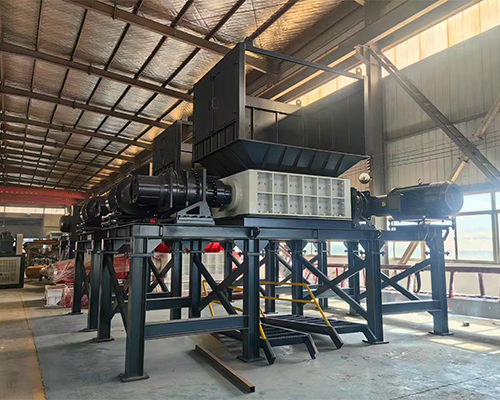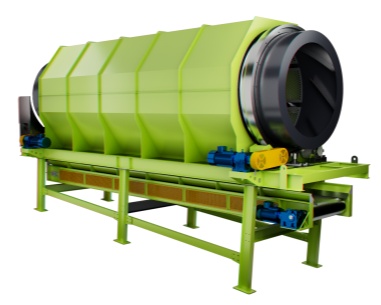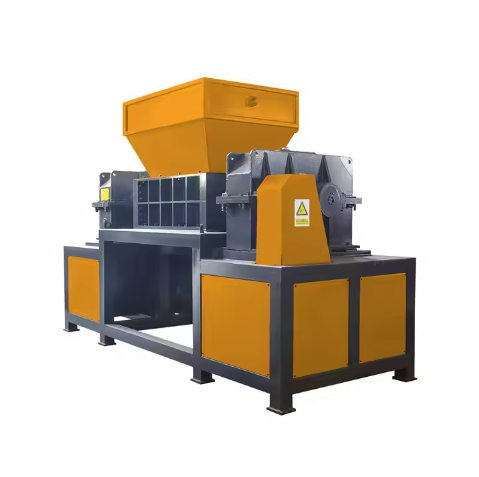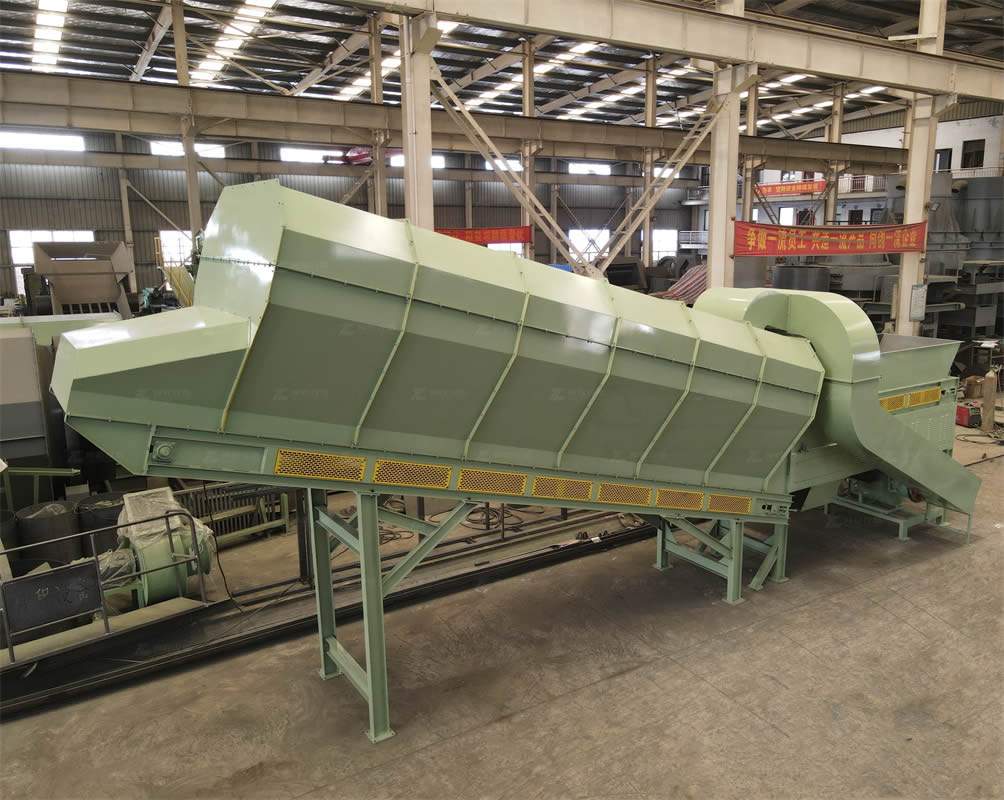working principle of double-shaft shredder
The difference analysis of the working principle of double-shaft shredder in different industries

Although the core architecture of the two-axis shredder is the same, the details of its working principle show certain differences when different industries respond to diverse materials and different needs.
First, environmental recycling industry
In the scrap metal treatment link, in the face of large and heavy metal parts such as scrap car shells and scrap steel beams, the motor of the dual-shaft shredder and the reducer need to output more torque to ensure that the knife shaft has enough strength to cut into and tear the metal. The blade is mostly made of alloy materials with high hardness, high temperature resistance and good toughness, such as tungsten steel alloy blade, whose special blade design can create cracks on the metal surface like a "wedge", and with the strong shear force brought by the high-speed rotation of the knife shaft, the metal is gradually disassembled into fist-sized pieces for subsequent smelting and recovery.
When dealing with waste plastics, taking into account the flexibility and easy winding characteristics of plastics, the rotational speed of the tool shaft will be appropriately reduced to avoid the plastic overheating due to high-speed friction melting and sticking to the blade. The blade shape tends to have a serrated or hook-like structure, which can effectively "hook" the plastic and stretch and tear, while the equipment is often equipped with air cooling or water cooling devices to maintain a low temperature environment, ensure that the plastic continues to tear smoothly, and turn it into uniform plastic particles for the production of recycled plastic products.
2. Agriculture
For straw treatment, due to the light texture of the straw and the long and loose fiber, the feed port of the two-axis shredder is usually designed to be wide and with an auxiliary feeding device, such as a conveyor belt or a feeding roller, to help the straw evenly and quickly enter the shredding chamber. The blade spacing on the knife shaft is large, the spiral distribution, the rotation can be like a "comb" to grasp the straw, the use of moderate shear force to cut the straw into small sections, convenient for subsequent composting or as a raw material for biomass fuel preparation, some will also be integrated dust removal device, reduce the dust pollution caused by straw crushing.
When dealing with branches and trunks, because the hardness of the material is higher than that of straw, the torque of the tool shaft should be increased, the blade should be made of sharper and thicker alloy steel, and the blade Angle is optimized to enhance the cutting ability. When working, the two knife axes are closely occluding, and the strong extrusion pressure is combined with the shear force to split and crush the branches from the middle, making it suitable for biomass power generation and wood chip processing. The discharge port may also be equipped with a screening device to distinguish different sizes of wood.
Third, the construction industry
There are a large number of bricks and concrete blocks in the construction waste, and the key components are strengthened and upgraded in response to its high hardness and high wear characteristics. The motor power is increased, the reducer is selected with heavy-duty type, the cutter shaft is made of coarse high-strength steel, and the blade is embedded with carbide cutter head to improve the wear resistance. In the crushing process, the knife shaft runs at a low speed and high torque, and uses the impact of the front of the blade and the shear of the side to crush the hard construction waste like a "hammer chisel", and the coarse aggregate produced can be directly used for road base laying, foundation backfilling, etc., to meet the requirements of the construction industry for aggregate size and strength.
Different from the disposal of construction waste, when dismantling the used building formwork, more attention is paid to preserving the integrity of the wooden board for secondary use. The shaft speed is moderate, the blade is thin and the edge is sharp. By accurately controlling the gap between the shaft of the knife, the template is finely cut to reduce the damage of the board. After shredding, the board can be reprocessed into small building components or packaging materials to maximize the reuse of resources.
In short, according to the material characteristics and target output of different industries, the two-axis shredder flexibly adjusts the power, tools, feeding and discharging links, accurate adaptation, and efficient completion of all kinds of material pretreatment tasks.
| Model | 600 | 800 | 1000 | 1200 | 1400 | 1600 | 1800 |
| Motor(kw) | 11*2 | 18.5*2 | 35*2 | 45*2 | 55*2 | 75*2 | 110*2 |
Reducer | P6-P7 | P7-P8 | P8-P10 | P10-P12 | P11-P13 | P12-P16 | P14-P16 |
| Siemens or other motors, planetary reducers or other reducers can be customized according to customer requirements | |||||||
| Rotation Speed | 8-20rmp | 8-20rmp | 8-15rmp | 8-15rmp | 8-15rmp | 8-12rmp | 8-12rmp |
| Blades Diameter | 220-320 | 260-320 | 260-400 | 400-500 | 400-500 | 500 | 500 |
| Blades material | The material of the blades (55sicr, 5crsi, 9crsi, skd11, m6v, h13) can be customizedaccording to the customer's actual usage | ||||||
| Feeding Size | 1200*900mm | 1400*1000mm | 1600*1200mm | 1800*1300mm | 2000*1300mm | 2200*1700mm | 2400*2000mm |
| The size and appearance of the feeding hopper can be customized according to thecustomer's feeding situation | |||||||
| Weight(kg) | 1800 | 2500 | 3700 | 5500 | 7500 | 9500 | 13000 |
-
 Trommel screenTrommel screen, also known as drum screens, are widely used in various industries for sorting and separating materials.Get Quote
Trommel screenTrommel screen, also known as drum screens, are widely used in various industries for sorting and separating materials.Get Quote -
 Crop straw double shaft shreddApplications:Biomass Energy Production: Shredded straw can be used as a feedstock for bioenergy plants to produce electricity or heat.Livestock Feed: Reduced-si...Get Quote
Crop straw double shaft shreddApplications:Biomass Energy Production: Shredded straw can be used as a feedstock for bioenergy plants to produce electricity or heat.Livestock Feed: Reduced-si...Get Quote -
 Zhongcheng Air Drum SeparatorAir drum separators effectively separate lightweight materials (e.g., plastics, paper) from heavier materials (e.g., metals, glass). This high efficiency is cru...Get Quote
Zhongcheng Air Drum SeparatorAir drum separators effectively separate lightweight materials (e.g., plastics, paper) from heavier materials (e.g., metals, glass). This high efficiency is cru...Get Quote
-
2024-06-11Optimize Your Waste Management Today with Our Advanced Drum ScreensUnderstanding the Mechanism and Optimization of Drum Screens for Waste Management
-
2023-01-12Double-Shaft ShredderThe Double-shaft shredder is a widely used industrial shredder that efficiently processes various mixed waste materials, such as construction waste, industrial ...
-
2024-10-23Solid waste recycling plantOur company engaged in waste sorting system . We are professional about waste sorting system . We have professional technical team. Professional technical team...
-
2024-05-28Garbage screening drum screenTrommel screen is consisting of five parts: drum, frame, hopper, reducer and motor.After the material goes into the drum, it is screened along with the rotation...
-
2023-01-18RDF Making MachineRDF (Refuse Derived Fuel) making machine is a specialized equipment used in waste management and energy recovery processes. Its primary function is to convert v...



